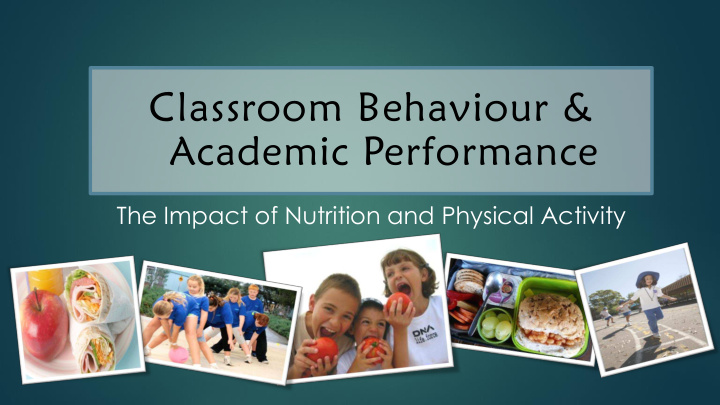



Classroom Behaviour & Academic Performance The Impact of Nutrition and Physical Activity
Current Nutrition and Physical Activity Behaviours
Meeting the Australian Dietary Guidelines
What else is happening with Nutrition? = 41% of teenagers energy And 40% ≥ two sugary drinks daily 4 x larger takeaways 16% no breakfast
Hydration Almost two thirds of the children in this large cohort had evidence of a hydration deficit when they went to school in the morning, despite breakfast intake.
Physical Activity Meeting Physical Activity Recommendations 40 Proportion of students (%) 35 30 Less than 25 % meet guideline 25 20 15 12% Yr 6 girls meet guideline 10 Declines with age 5 0 Year K Year 2 Year 4 Year 6 All Primary Years Boys Girls
Fundamental Movement Skills Year 6 Boys Mastery of FMS Year 6 Girls Mastery of FMS 70 70 60 60 Proportion of students (%) Proportion of students (%) 50 50 40 40 30 30 20 20 10 10 0 0 1997 2004 2010 2015 1997 2004 2010 2015 Catch Kick Overarm throw Vertical jump Sprint run Catch Kick Overarm throw Vertical jump Sprint run
Sedentary Behaviour Weekday sedentary behaviour 400 350 300 250 Median time (min) 200 150 100 50 0 K Boys K Girls 2 Boys 2 Girls 4 Boys 4 Girls 6 Boys 6 Girls 8 Boys 8 Girls 10 10 Girls Boys Travel Social Screen time (Smart phone/tablet) Screen time (no smart phone/tablet Educational Cultural
What are the Implications for Classroom Behaviour and Academic Performance?
Classroom Behaviour Iron, Thiamine (B1) & Frequent hunger V/F/ W’grains : Imp Zinc deficiencies are results in greater behaviour, linked with irritability, emotional & socialisation, fatigue, aggressive & behavioural engagement behaviour changes problems Regular breakfast is Nutriti rition: on: linked with improved Healthy eating behaviour Breakfast Excess sugar intake Limiting occasional increases off-task & foods aggressive behaviours
Memory & Concentration Regularly skipping Low GI breakfasts breakfast increases improve concentration errors & slower for longer periods of memory recall time Regular breakfast consumption improves memory & concentration Nutriti rition: on: Healthy eating School breakfast programs Breakfast improve concentration, Limiting occasional alertness & memory foods
Academic Performance Healthy eating habits • higher exam results 1.5 times more likely to • fruit and veg = increase have poor school 6-11% points performance with high Healthy snacks intakes of sugary drinks & are associated fast food with higher exam results Nutrition: Healthy Eating Regular breakfast Fruit, vegetables & consumption dairy resulted in Higher grades in Science, English & Maths
Integrating PA into the Curriculum Almost two thirds of the children in this large cohort had evidence of a hydration deficit when they went to school in the morning, despite breakfast intake.
Classroom Behaviour Incorporating Physical activity into different KLAs Short bouts of reduces off-task exercise improve behaviour by 20.5% on-task behaviour Physical Activity: Immediately after physical activity students are better Energisers able to concentrate on tasks Active Lessons Sport
Memory & Concentration Short bouts of Improvements are Active lessons exercise improve maintained over improve memory & time with regular concentration on concentration physical activity academic tasks After PA students can concentrate on tasks, remain focused & enhance Physical learning better Activity: Energisers Sedentary behaviours Active Lessons impact memory, recall & Sport ability to multi-task
Academic Performance 2-4 times more likely to pass reading & maths Vigorous intensity when participating in physical activity vigorous intensity leads to higher exam physical activity results 60 minutes of physical activity in maths lessons 3 times per week increased class Physical average exam results Activity: Replacing academic time with physical activity does Energisers not affect academic Active Lessons outcomes Sport
Concentration, Short T erm Memory, Mood Water consumption Improvements in has a significant sustained attention impact on alertness are seen with and arousal providing water in Water thirsty children consumption improves short term memory Water absorption peaks in 20 - 60 min after drinking. Cognitive performance Hydration: changes within a critical window of 20-45 min Maintaining adequate hydration
Health Promoting Schools Framework
What Can I Do? In the Classroom Role model healthy eating Encourage children and parents to pack healthy lunchboxes Introduce ‘Crunch & Sip’ into the classroom Healthy rewards (using non-treat rewards i.e. star charts) Teach healthy eating in the classroom (i.e. using fun and engaging resources) Active Lessons - Include physical activity across the curriculum Energisers – short physical activity breaks throughout the day
What Can I Do? Within the School Environment Encourage water consumption Endorse the Healthy School Canteen Policy School vegetable garden (or growing vegetables in the classroom) School Breakfast Program Promote nutrition campaigns (e.g. Fruit & Veg Month) and market healthy eating with the school environment Encourage active play and sport at lunch and recess Make sure children reach the mandated 150 minutes of physical activity per week
Nutrition
Physical Activity
Resource pack: This presentation Nutrition and Physical Activity Impact on Classroom Behaviour and Academic Performance Literature Review & Other Summary and work sheet Vegetable Gardening in the Classroom Kids in the Kitchen Manual Links to nutrition and physical activity resources
Tools & Resources
Thank you
Recommend
More recommend